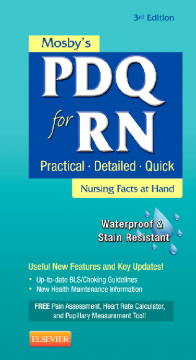
Additional Information
Book Details
Abstract
Easily locate critical clinical information at a moment's notice with Mosby's PDQ. This easy-to-use, pocket-sized guide is your rapid reference to the hundreds of important nursing facts, formulas, lab values, and procedures you might need in the clinical setting. 10 color coded sections break out key coverage of drugs, emergency care, pediatrics, patient teaching, obstetrics, geriatrics, patient assessment, and more. A special facts sections contains additional information on essential formulas, conversion tables, and abbreviations.
- 10 tabbed, color-coded sections with contents listed on each divider give you quick access to hundreds of essential facts, formulas, lab values, procedures, ECG info, and more within each section.
- Durable and buoyant waterproof paper can be written on and wiped off as needed.
- Handy bookmark/ruler easily slides in and out and includes a variety of important measurements including inches, millimeters, pupillary size, pain rating, and heart rate.
- Pocket size format and spiral binding makes this book easy to carry and use in any clinical setting.
- Commonly used but rarely memorized clinical information, such as charts, graphs, formulas, conversions, and lab values, is included to help you have vital information right on hand to deliver safe and effective nursing care.
- Tabs for obstetric, pediatric, and geriatric information enables you to easily find information to treat these specialized populations.
- Printed on waterproof and stain-resistant paper, this durable reference is tough enough for any clinical setting and will even float if it falls into water.
- A ruler with selected standard measurements slides in and out of the spiral binding and serves as a handy bookmark.
- All information is HIPAA and OSHA compliant to keep you current with the latest practice standards and guidelines.
- A new Geriatrics tab offers quick access to information specific to caring for older adults.
- Vital Signs and Assessment are combined in one section for quick reference.
- New and expanded information on emergency care provides essential guidelines for treating stroke patients, assessing trauma patients, and responding to cardiopulmonary arrest.
- Additional patient teaching resources, such as reliable web sites and cancer screening recommendations, help you communicate more effectively with your patients.
